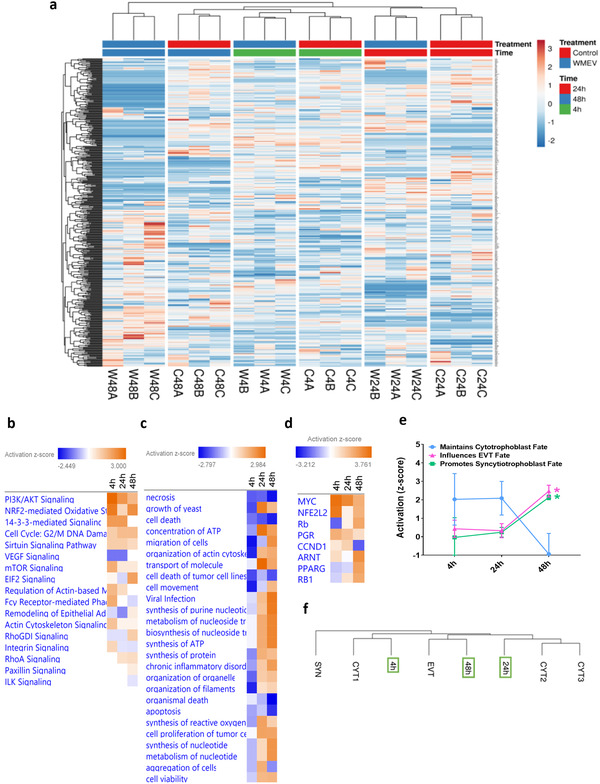Figure 4.

Watermelon extracellular vesicles alters the impact of intestinal epithelial cell secretome on human placental trophoblast proteome. Basal conditioned medium was obtained from untreated (control) Caco‐2 cells or Caco‐2 cells cultured apically with 2.5 × 1010 mL−1 watermelon extracellular vesicles (WMEV) for 4 h (n = 6 pooled), and applied to BeWo cells for 4, 24, or 48 h. Mass spectrometry was used to characterize the proteome of these BeWo cells. a) Hierarchical clustering analysis (Euclidean clustering, complete linkage) of all proteins detected in lysates from BeWo cells incubated with basal medium from Caco‐2 control‐ (C) or WMEV (W) treated‐ cells (n = 3, labeled A–C) at 4, 24, or 48 h. BeWo cell proteomes (all 448 proteins) were subjected to b) Ingenuity pathway, c) functional, and d) upstream regulator enrichment analyses to predict potential impact on placental function. Color coding shows Z‐score value for predicted activation (>0) or inactivation (<0) of pathway activity. e) The identified transcription factors with known roles in trophoblast biology were classified by their influence on trophoblast differentiation in the following categories: “Maintains cytotrophoblast fate” (blue); “Promotes EVT fate” (red), and “Promotes syncytiotrophoblast fate” (green). Data are presented as mean ± standard deviation. Two‐Way ANOVA with Sidak's multiple comparisons test, * = p < 0.05. e) The proteome of BeWo cells exposed to WMEV‐induced intestinal secretome (fold‐change from time‐matched control) were compared with the published transcriptome of primary trophoblast subtypes.[ 34 ] Syncytiotrophoblast (SYN), extravillous trophoblast (EVT), undifferentiated primary cytotrophoblast (CYT1), or differentiating primary cytotrophoblast (CYT2 and CYT3). BeWo cells treated for 4 h cluster with undifferentiated cytotrophoblast (CYT); 24 h‐treated cells cluster with differentiating (syncytializing) cytotrophoblast (CYT2, CYT3); 48 h‐treated cells cluster closely with EVTs.
